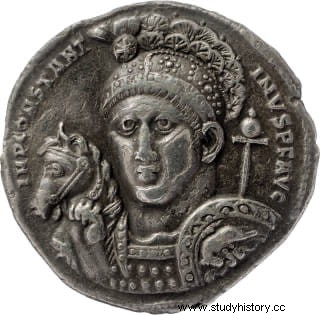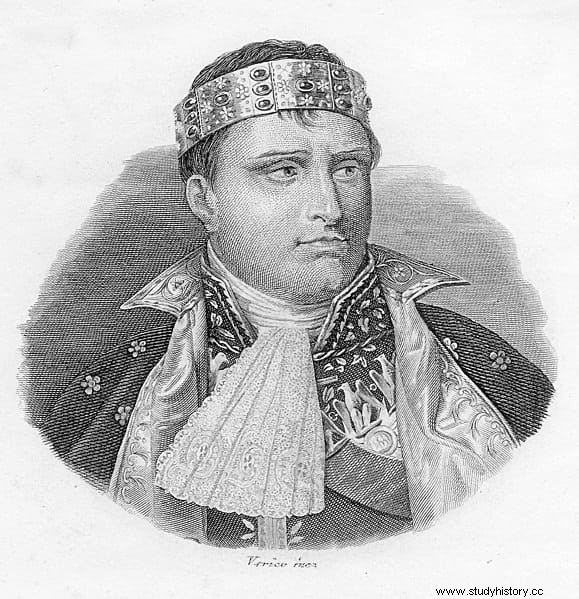In the cathedral of Monza in Italy there is a curious crown that is not made of iron but which has been known, since the early Middle Ages, as the Iron Crown. The name derives from the belief that an inner sheet that holds the plates together was made of that metal, although it is actually silver.
It is made up of six plates of an alloy that is 84 percent gold and the rest silver, held together by hinges (except for one that appears to be missing). Each plate has two sections, the first larger and with a precious stone in the center surrounded by four seven-petal gold rosettes, as well as colored enamels with floral motifs in the corners. The second section of each plate is narrow and contains three gems (except for one of the plates which only has one gem and two gold rosettes).
The crown is irregularly circular in shape with an inner diameter of just 15 centimeters and a circumference of 48 centimeters. In total, it has 26 gold rosettes, seven sapphires, seven garnets and four amethysts. The rest of the elements are simple colored glass. The plates are 53 millimeters high and are fixed with an inner silver foil one centimeter high and one millimeter thick.

It is this inner sheet that gave the crown its name when it was thought to be made of iron and not silver. According to tradition, when in the year 324 AD. Elena, the mother of Emperor Constantine, had Golgotha excavated and she found the cross on which the nails were still. She left the cross in Jerusalem but took the nails with her to Rome. She had one of them created a horse bit and used the other on her son's helmet, with which both the emperor and his horse would be protected in battle.
During the Middle Ages, the nail of the legend was identified with the aforementioned inner layer of the crown, a belief that lasted until recent analyzes that confirmed the mistake. However, the crown could have been part of the emperor's helmet. This is what the historian Valeriana Maspero, one of the main scholars of the piece, assures.
According to Maspero, what is known as the Iron Crown is nothing more than the diadem that was mounted on Constantine's helmet. The Ostrogothic monarch Theodoric the Great would have claimed the helmet and bit from Constantinople as part of his right to be king of Italy. The Byzantines agreed, but Emperor Anastasius I sent him only the diadem, keeping the rest of the helmet (which was on display in the Saint Sophia Cathedral until the Crusaders took the city in 1204, when it disappeared). Theodoric would have adopted the diadem as a crown, which would later have been transmitted by the Ostrogoths to the Lombards. For this reason, it was used by Charlemagne in his coronation as King of the Lombards.

Experts date its manufacture to around the 4th-5th century, although some elements are later, between 445 and 565 the oldest and between 690 and 975 the most modern. Evidence that the crown was modified or repaired over the centuries. Some scholars even believe that it was originally made up of 8 plates, instead of 6, which would have been reduced in Constantinople in order to give a smaller crown to a barbarian king. like Theodoric.
Others are of the opinion that it was Charlemagne who modified it, so that it could be used in the coronation of his son Pepin as King of Italy in 781. After Pepin, the crown was used in the coronation of at least five other kings:Otto III in the year 966, Conrad II in 1026, Conrad of Lorraine in 1093, Conrad III in 1128 and Frederick Barbarossa in 1155. However, the historian Bartolomeo Zucchi wrote around the year 1600 that the crown had been worn 34 times since the 9th century to the XVII.
One such occasion may have been the coronation of Charles I of Spain (Emperor Charles V) in February 1530, simultaneously with his imperial coronation in Bologna.

On May 26, 1804, Napoleon Bonaparte was crowned King of Italy in the Milan Cathedral. He himself placed the Iron Crown on his head, while saying God has given it to me, woe to those who take it away .
After the fall of Napoleon and the creation of the Lombard-Venetian Kingdom in 1815, the crown became his royal insignia. She then suffered numerous ups and downs, being taken to Vienna, then to Venice and Turin. During the First World War it was kept briefly in Rome, and in the Second World War it was kept in the Vatican, where it remained until the end of the conflict. The last two kings of Italy, Victor Emmanuel III and Umberto II, did not want any coronation ceremony and therefore did not use it.
Today the Iron Crown is kept on the altar of the Teodolinda chapel in Monza Cathedral, to which it was originally donated by King Berengar I of Italy in 874.
